How 3D Printing Could Influence Affordable Housing
With benefits including increased efficiencies and reduced labor, 3D concrete printing is capturing the attention of the housing industry, including for affordable projects like those of Habitat for Humanity.
March 24, 2022
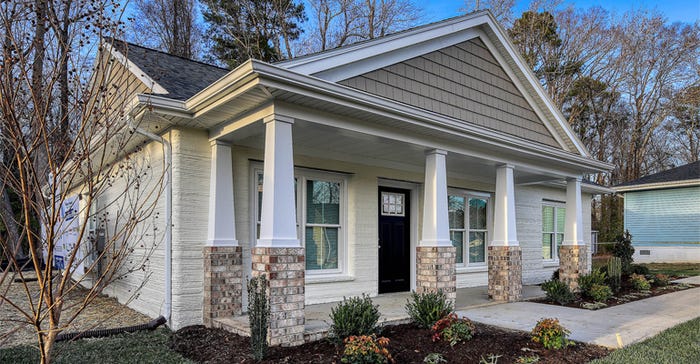
During the International Builders’ Show in February, attendees were treated to a surprise exhibit when Black Buffalo 3D printed a concrete home in the parking lot as it unveiled its new NEXCON 1G 3D concrete printer. It was similar to what had taken place less than a month earlier at World of Concrete, where COBOD International held live demonstrations of its 3D-printing technology, building short walls before attendees’ eyes in the middle of the Las Vegas Convention Center’s Riviera parking lot.
3D printing is quickly capturing the attention of the construction industry as it has moved from desktop hobby using plastics to large-scale applications with heavy-duty concrete materials in just a few years. With expected benefits including time savings and less waste, the possibilities for residential construction abound at a time when the industry faces ongoing challenges with labor, supply, and inventory.
3D Printing for Housing
The technologies for 3D concrete printing vary from company to company. Black Buffalo 3D’s new NEXCON printer features a gantry frame and a fully modular track system; proprietary concrete is pumped through a nozzle as the machine moves along the rails, allowing for full customization based on the house plans and accommodating structures up the three stories tall. The modular nature of the rail system could allow for applications as long as row homes, though currently single-family homes of about 1,600 square feet are the norm. The company says its speed is only capped by OSHA safety regulations and prints at the allowable 9.8 inches per second.
The machine, silo, and pump system are delivered to the jobsite in three semi-truck containers and takes about 12 hours to assemble.
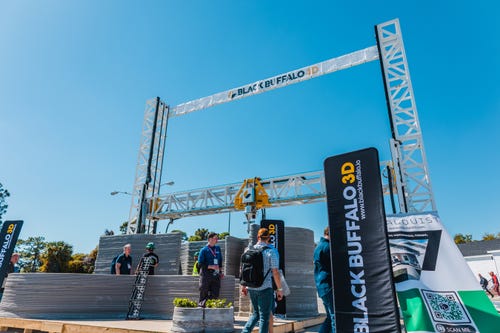
COBOD’s gantry-style printer also is delivered in one or two shipping containers, and then can be transferred from site to site on a flatbed truck. It operates on an X, Y, and Z axis, delivering concrete through a nozzle and building layer by layer. 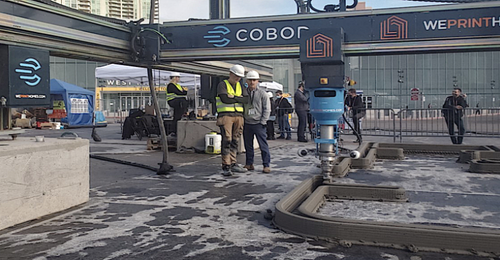
SQ4D’s Autonomous Robotic Construction System (ARCS) sets up in about six to eight hours and requires three to four workers to operate. Kristen Henry, the company's chief technology officer, says the machine's nozzle turns as it makes corners, allowing for a clean profile. Along with the walls, ARCS is capable of printing the footings, foundation wall, and slab.
The company’s first 3D printed home for sale, a 1,407-square-foot project in Riverhead, New York, listed for $299,999, which SQ4D says is 50% below the cost of comparable new homes in the area, and sold for $360,000.
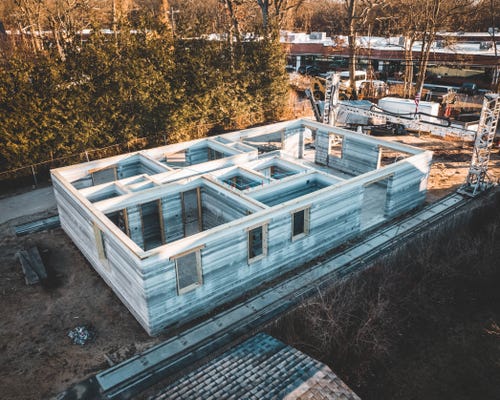
The concrete for these types of systems is similar to traditional concrete, but in special formulations to ensure flow through the system. Black Buffalo 3D has a proprietary structural dry-mix mortar undergoing testing for ICC-ES criterial for 3D printed walls. COBOD’s technology is fully open-source; customers can use, for example, dry-mix single-component products such as Quikrete’s mixes or alternatively real concrete mixed on site using materials from local suppliers, which the company says provides material cost savings of a factor of six to 10 over proprietary mixes. SQ4D also uses a non-proprietary mix with local materials; Henry says their material recently compressive trested around 9,000 psi.
Saving Time, Money, and Waste
Some of the biggest advantages of 3D printing are time savings and increased efficiency.
“Using 3D printers allows you to build homes more quickly versus conventional methods,” says Philip Lund-Nielsen, co-founder and head of Americas for COBOD. “We’re not far from a future where you can print a 2,100-square-foot home in five days, extrapolating based on our clients’ printing experience on six continents.”
Black Buffalo 3D says its NEXCON machine can print a 1,000-square-foot space—two 2-inch-thick load-bearing walls with a 4-inch gap in between—in about 22 hours, depending on crew experience. The company says the cost is about 40% less compared to stick-frame or CMUs, and the system requires about four people to run.
Alquist, a 3D printing construction company working on housing projects across a range of sizes but with a focused mission to solve the nation's affordable housing crisis, is seeing cost savings with concrete printing to be at about 10% to 15%. “We do believe, though, that in next two years savings will increase to about 30%,” says Founder & CEO Zachary Mannheimer. “We know in the next two years there will be a major advancement in the technology and a major advancement in the experience.”
Unlike off-site fabrication, on-site 3D printing provides flexibility of size and shape because there’s no accommodation required for transport. Rebar requirements also may be reduced without the concerns about vibration during shipping.
3D concrete printing helps reduce jobsite material waste because you’re only printing what you need and can design the home to more material-efficient shapes and layouts. “3D printing vastly increases design freedom in the building process, enabling more people to live in a unique building instead of the standard rectangles that most of us currently call home,” Lund-Nielsen notes. “Printing something complex versus simple does not change the cost, meaning we can now print beautiful curves that would have otherwise been too expensive with conventional methods. In Germany, our partner PERI even 3D printed a bathtub, and we expect tons more of great use cases in the future."
Of course, 3D technology isn’t without its challenges, first and foremost simply being its newness. “With any new technology, it’s always about broad acceptance and incorporation into the business model of the customer, in this case the builder,” notes Michael Woods, CEO/COO of Black Buffalo 3D.
Still, they’ve noticed a swell of interest in learning about the technology. “When we debuted at IBS, we expected objections,” says Peter Cooperman, Black Buffalo 3D’s head of marketing & strategy. “But we even had framers coming up to us to see if we trained on the technology.”
Alquist has created a workforce development program to help high school and community college students become certified in 3D-printed construction. “That’s great for the industry and great for us—we need to hire 30 people in the next year," says Mannheimer. “We’re not just creating new jobs … we’re creating a new industry.”
The company also is dedicated to the R&D element of 3D-printed homes, and is working with universities to study wind shear resistance, seismic resistance, storm resistance, structual capacities, and other elements, as well as into 3D-printed raw materials beyond traditional concrete, such as hemp and fly ash.
Henry notes that familiarity at building departments is still an obstacle in some areas of the country, "but we’ve found that as we take this technology to new counties and towns, once building departments understand, we move the process along very well.”
Architects also will need to get up to speed, she says, in order to fully take advantage of the design freedom that 3D printing provides.
Along with the challenges of adoption, the technology still faces some limitations in its use; for example, roofing isn't yet an option. But the technology is advancing quickly, so there’s no telling what might be possible shortly down the road.
3D Printing’s Applications for Affordable Housing
As 3D-printed homes spring up around the world, early adopters run the gamut from large production communities to unique custom homes to non-profit operations.
Lennar, the country’s second-largest home builder, is breaking ground on a 100-home community in Austin, Texas. Co-designed by BIG-Bjarke Ingels Group, the homes will be built using ICON’s Vulcan 3D printing system. Vulcan can print homes up to 3,000 square feet. ICON also printed the East 17th Street Residences, the first 3D homes offered for sale in the U.S. The four houses in East Austin feature modern, minimalist styling, large covered porches, and footprints from 900 to 2,000 square feet. At SXSW this month, ICON and architecture firm Lake|Flato unveiled “House Zero,” boasting an elevated mid-century modern ranch design alongside energy efficiency and resiliency.
![]()
For affordable housing, the time and cost savings associated with 3D concrete printing may help alleviate some of the budget pressures, and the labor efficiencies are particularly welcome for projects that rely on volunteers and sweat equity, such as those that Habitat for Humanity builds. Like other concrete homes, 3D-printed projects also bring long-term energy savings to homeowners. Black Buffalo 3D’s two-part walls for example, provide a thermal break that increases the R-value over a traditionally insulated wall.
In December, Alquist completed Habitat for Humanity's first 3D printed house, a three-bed/two-bath 1,200-square-foot home for a family in Williamsburg, Va. Using a COBOD BOD 2 3D printer, Alquist crews printed the house in 28 hours, which Habitat says is at least a four-week reduction in its standard construction schedule.
“Alquist’s use of concrete for the walls saved an estimated 15% per square foot in building costs,” says Habitat for Humanity Peninsula and Greater Williamsburg. “Concrete better retains temperature, saving on heating and cooling costs, and is more resistant to tornado and hurricane damage.”
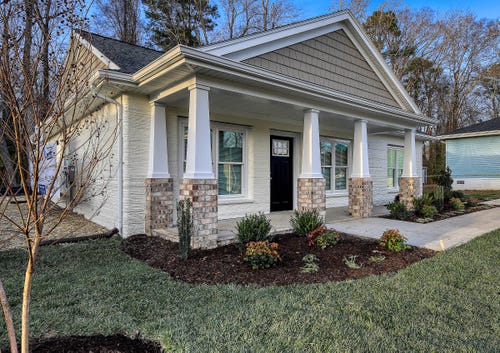
Alquist also included a 3D printer in the kitchen, which will allow the homeowner to print knobs, light switch covers, and other replaceable parts.
PERI worked with Habitat for Humanity Central Arizona on its first 3D-printed home in the U.S., completed early this year. Almost 80% of the 1,738-square-foot home was built with COBOD's BOD 2 3D printer.
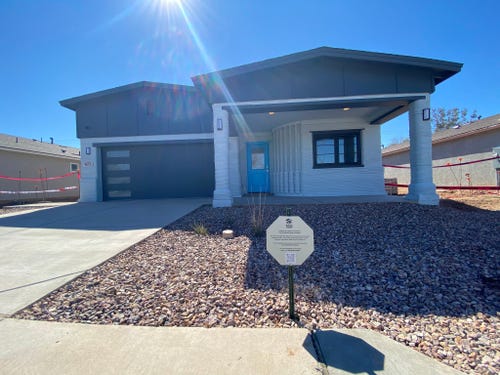
New Spirit Village in Rogue Valley, Oregon, plans to use 3D concrete printing for the 84 affordable homes in its community. Along with the technology’s cost-saving benefits, concrete’s fire resistance is a key attribute for the community, which was devastated by a wildfire in 2020.
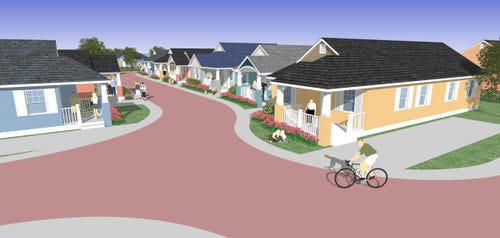
A side benefit of 3D printing, at least for now, is the added attention brought by applying an exciting new technology.
If the buzz around Black Buffalo 3D’s and COBOD’s recent demonstrations, as well as the frequent media publicity in towns where houses have been completed, is any indication, attention on 3D concrete printing is only building. Alquist alone is receiving 50 requests for 3D homes per hour since the Williamsburg Habitat home was completed in December.
“I think the industry is ready to start transitioning and adopting to new methods,” Cooperman says. Natural disasters, wars, inventory shortages, and the pandemic “show that you not only have to come up with better ways to rebuild, you really need more resilient housing. …. You need a new method to make sure people are getting what they need.”
Click on the slide show to view more images of completed and in-progress projects.
About the Author(s)
You May Also Like




